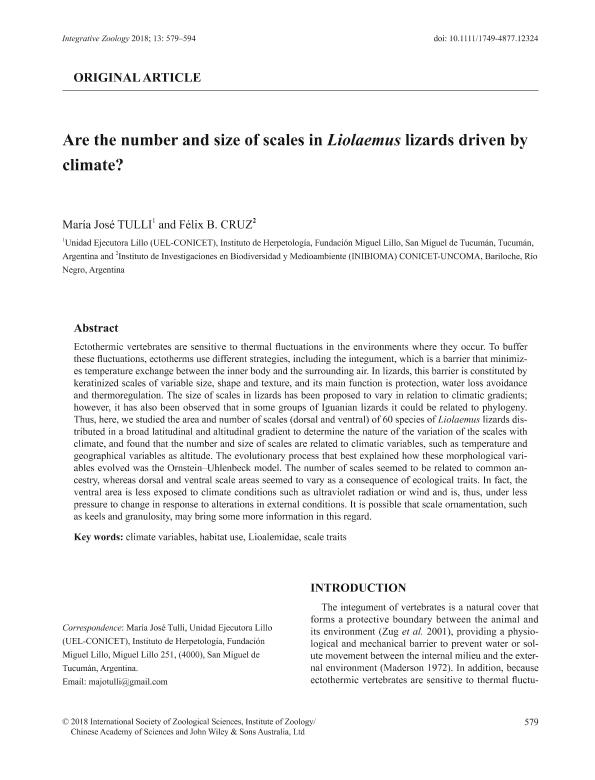Mostrar el registro sencillo del ítem
dc.contributor.author
Tulli, María José

dc.contributor.author
Cruz, Felix Benjamin

dc.date.available
2023-06-14T20:17:26Z
dc.date.issued
2018-09
dc.identifier.citation
Tulli, María José; Cruz, Felix Benjamin; Are the number and size of scales in Liolaemus lizards driven by climate?; Wiley-Blackwell; Integrative Zoology; 13; 5; 9-2018; 579-594
dc.identifier.issn
1749-4877
dc.identifier.uri
http://hdl.handle.net/11336/200655
dc.description.abstract
Ectothermic vertebrates are sensitive to thermal fluctuations in the environments where they occur. To buffer these fluctuations, ectotherms use different strategies, including the integument, which is a barrier that minimizes temperature exchange between the inner body and the surrounding air. In lizards, this barrier is constituted by keratinized scales of variable size, shape and texture, and its main function is protection, water loss avoidance and thermoregulation. The size of scales in lizards has been proposed to vary in relation to climatic gradients; however, it has also been observed that in some groups of Iguanian lizards it could be related to phylogeny. Thus, here, we studied the area and number of scales (dorsal and ventral) of 60 species of Liolaemus lizards distributed in a broad latitudinal and altitudinal gradient to determine the nature of the variation of the scales with climate, and found that the number and size of scales are related to climatic variables, such as temperature and geographical variables as altitude. The evolutionary process that best explained how these morphological variables evolved was the Ornstein-Uhlenbeck model. The number of scales seemed to be related to common ancestry, whereas dorsal and ventral scale areas seemed to vary as a consequence of ecological traits. In fact, the ventral area is less exposed to climate conditions such as ultraviolet radiation or wind and is, thus, under less pressure to change in response to alterations in external conditions. It is possible that scale ornamentation, such as keels and granulosity, may bring some more information in this regard.
dc.format
application/pdf
dc.language.iso
eng
dc.publisher
Wiley-Blackwell

dc.rights
info:eu-repo/semantics/openAccess
dc.rights
Atribución-NoComercial-CompartirIgual 2.5 Argentina (CC BY-NC-SA 2.5 AR)
dc.rights.uri
https://creativecommons.org/licenses/by-nc-sa/2.5/ar/
dc.subject
CLIMATE VARIABLES
dc.subject
HABITAT USE
dc.subject
LIOALEMIDAE
dc.subject
SCALE TRAITS
dc.subject.classification
Ecología

dc.subject.classification
Ciencias Biológicas

dc.subject.classification
CIENCIAS NATURALES Y EXACTAS

dc.title
Are the number and size of scales in Liolaemus lizards driven by climate?
dc.type
info:eu-repo/semantics/article
dc.type
info:ar-repo/semantics/artículo
dc.type
info:eu-repo/semantics/publishedVersion
dc.date.updated
2023-05-29T15:52:46Z
dc.journal.volume
13
dc.journal.number
5
dc.journal.pagination
579-594
dc.journal.pais
Reino Unido

dc.journal.ciudad
Londres
dc.description.fil
Fil: Tulli, María José. Consejo Nacional de Investigaciones Científicas y Técnicas. Centro Científico Tecnológico - Tucumán. Unidad Ejecutora Lillo; Argentina. Universidad Nacional de Tucumán. Facultad de Ciencias Naturales e Instituto Miguel Lillo; Argentina
dc.description.fil
Fil: Cruz, Felix Benjamin. Consejo Nacional de Investigaciones Científicas y Técnicas. Centro Científico Tecnológico Conicet - Patagonia Norte. Instituto de Investigaciones en Biodiversidad y Medioambiente. Universidad Nacional del Comahue. Centro Regional Universidad Bariloche. Instituto de Investigaciones en Biodiversidad y Medioambiente; Argentina
dc.journal.title
Integrative Zoology
dc.relation.alternativeid
info:eu-repo/semantics/altIdentifier/url/https://onlinelibrary.wiley.com/doi/10.1111/1749-4877.12324
dc.relation.alternativeid
info:eu-repo/semantics/altIdentifier/doi/http://dx.doi.org/10.1111/1749-4877.12324
Archivos asociados
